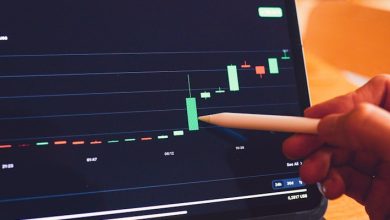How to Use Technical Analysis in Crypto Trading

- Understanding the basics of technical analysis
- Common technical indicators used in crypto trading
- Using chart patterns to make trading decisions
- Implementing support and resistance levels in your analysis
- Utilizing moving averages for trend identification
- Combining technical analysis with fundamental analysis for better trading outcomes
Understanding the basics of technical analysis
When it comes to trading in the crypto market, technical analysis plays a crucial role in making informed decisions. Understanding the basics of technical analysis can help traders identify trends and patterns in price movements, which can be used to predict future price movements.
Technical analysis involves analyzing historical price data, volume, and other market indicators to determine the direction in which an asset is likely to move. By studying charts and graphs, traders can identify support and resistance levels, as well as trend lines that can help them make more accurate predictions about future price movements.
One of the key principles of technical analysis is that price movements are not random, but rather follow a pattern that can be identified and used to make profitable trades. By studying these patterns, traders can gain insight into market sentiment and make more informed decisions about when to buy or sell an asset.
Overall, understanding the basics of technical analysis is essential for anyone looking to trade in the crypto market. By learning how to read charts, identify trends, and interpret market indicators, traders can improve their chances of making successful trades and maximizing their profits.
Common technical indicators used in crypto trading
Common technical indicators are essential tools for traders in the cryptocurrency market. These indicators help traders analyze price trends, identify potential entry and exit points, and make informed trading decisions. Some of the most widely used technical indicators in crypto trading include:
- Moving Averages: Moving averages are used to smooth out price data and identify the direction of the trend. Traders often look for crossovers between short-term and long-term moving averages to signal potential buy or sell opportunities.
- Relative Strength Index (RSI): The RSI is a momentum oscillator that measures the speed and change of price movements. Traders use the RSI to determine whether a cryptocurrency is overbought or oversold, which can help predict potential trend reversals.
- Bollinger Bands: Bollinger Bands consist of a simple moving average and two standard deviations above and below the moving average. Traders use Bollinger Bands to identify periods of high volatility and potential price breakouts.
- MACD (Moving Average Convergence Divergence): The MACD is a trend-following momentum indicator that shows the relationship between two moving averages of a cryptocurrency’s price. Traders use the MACD to identify trend changes and potential buy or sell signals.
- Volume: Volume is a critical indicator in crypto trading as it shows the amount of activity in the market. Traders often look for increases in trading volume to confirm price trends and validate their trading decisions.
By using these common technical indicators in conjunction with other analysis tools, traders can gain valuable insights into the cryptocurrency market and make more informed trading decisions. It is important to understand how each indicator works and how to interpret their signals accurately to increase the likelihood of successful trades.
Using chart patterns to make trading decisions
Chart patterns are essential tools that traders use in technical analysis to make informed decisions when trading cryptocurrencies. By analyzing historical price movements, traders can identify patterns that may indicate future price movements, allowing them to enter and exit trades at optimal times.
There are several common chart patterns that traders look for when analyzing cryptocurrency price charts. Some of these patterns include triangles, head and shoulders, double tops and bottoms, and flags. Each pattern provides valuable information about the market sentiment and potential price direction.
For example, a symmetrical triangle pattern may suggest that the market is experiencing a period of consolidation before a potential breakout in either direction. On the other hand, a head and shoulders pattern may indicate a trend reversal, with the price likely to move in the opposite direction after the pattern is complete.
Traders can use these chart patterns to set price targets, stop-loss levels, and entry points for their trades. By combining chart patterns with other technical indicators, such as moving averages and relative strength index (RSI), traders can increase their chances of making profitable trades.
It is important to note that chart patterns are not foolproof and should be used in conjunction with other forms of analysis to make well-informed trading decisions. However, by learning to identify and interpret these patterns, traders can gain a better understanding of market dynamics and improve their overall trading performance in the cryptocurrency market.
Implementing support and resistance levels in your analysis
When conducting technical analysis in crypto trading, it is essential to implement support and resistance levels in your analysis. These levels play a crucial role in identifying potential entry and exit points for your trades.
Support levels are price points where a downward trend is expected to pause or reverse. Traders often use support levels to determine when to buy an asset, as it indicates a potential price floor. On the other hand, resistance levels are price points where an upward trend is expected to pause or reverse. Traders use resistance levels to decide when to sell an asset, as it signifies a potential price ceiling.
By incorporating support and resistance levels in your analysis, you can make more informed trading decisions. These levels can help you identify areas of potential price reversals, allowing you to set realistic profit targets and stop-loss orders. Additionally, support and resistance levels can help you determine the overall trend of an asset, enabling you to trade with the market momentum.
Utilizing moving averages for trend identification
One effective way to identify trends in crypto trading is by utilizing moving averages. Moving averages are a technical analysis tool that smooth out price data by creating a constantly updated average price. By analyzing the relationship between different moving averages, traders can gain insights into the direction of the market and potential entry or exit points for trades.
Using moving averages can help traders filter out the noise in price movements and focus on the overall trend. For example, a common strategy is to look for a “golden cross,” which occurs when a short-term moving average crosses above a long-term moving average. This can signal a bullish trend and potential buying opportunity.
Conversely, a “death cross” happens when a short-term moving average crosses below a long-term moving average, indicating a bearish trend and a possible selling opportunity. By paying attention to these crossovers and the slope of the moving averages, traders can make more informed decisions in their crypto trading activities.
Overall, incorporating moving averages into your technical analysis toolkit can provide valuable insights into market trends and help you make more informed trading decisions in the volatile world of cryptocurrency.
Combining technical analysis with fundamental analysis for better trading outcomes
Combining technical analysis with fundamental analysis can significantly improve your trading outcomes in the crypto market. While technical analysis focuses on price movements and trends, fundamental analysis looks at the underlying factors that drive market movements. By integrating these two approaches, traders can gain a more comprehensive understanding of the market and make better-informed decisions.
When using technical analysis, traders analyze historical price data, chart patterns, and indicators to predict future price movements. On the other hand, fundamental analysis involves evaluating the intrinsic value of a cryptocurrency based on factors such as technology, team expertise, market demand, and regulatory developments. By combining these two methods, traders can get a more holistic view of the market.
One way to combine technical and fundamental analysis is to use technical indicators to confirm or refute the signals generated by fundamental analysis. For example, if a fundamental analysis suggests that a particular cryptocurrency is undervalued, traders can use technical indicators to confirm whether the market sentiment aligns with this assessment. This can help traders make more accurate trading decisions.
Additionally, traders can use technical analysis to identify entry and exit points based on fundamental analysis insights. For instance, if fundamental analysis indicates that a cryptocurrency has strong growth potential, traders can use technical analysis to pinpoint optimal entry points to maximize profits. Conversely, technical analysis can also help traders identify exit points to minimize losses if the market sentiment turns bearish.
In conclusion, combining technical analysis with fundamental analysis can provide traders with a more comprehensive and nuanced understanding of the crypto market. By leveraging the strengths of both approaches, traders can enhance their trading strategies and improve their overall trading outcomes.



